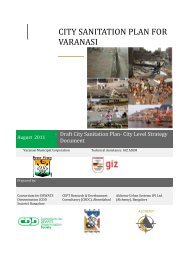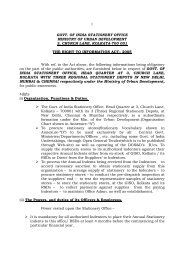City Sanitation Plan, Uttarakhand Detailed Plan report, Muni Ki Reti 1
City Sanitation Plan, Uttarakhand Detailed Plan report, Muni Ki Reti 1
City Sanitation Plan, Uttarakhand Detailed Plan report, Muni Ki Reti 1
Create successful ePaper yourself
Turn your PDF publications into a flip-book with our unique Google optimized e-Paper software.
<strong>City</strong> <strong>Sanitation</strong> <strong>Plan</strong>, <strong>Uttarakhand</strong><br />
Design of effluent disposal facilities for the collection, treatment and disposal of wastes is dictated<br />
primarily by the estimated organic loadings to be handled. In developing such estimates, it is<br />
necessary to determine on a unit basis not only the flow or volume of waste but its strength and<br />
composition too. With respect to flow, peak flow rates must be known in order to determine the<br />
required hydraulic capacities of sewer, pumping stations, treatment plants and effluent disposal<br />
facilities. Similarly, strength and composition must be known in order to determine the degree and<br />
type of treatment required to produce effluent of acceptable quality. A study of waste volumes and<br />
its characteristic are a preliminary necessity to the development of Design Criteria.<br />
As a preface to a detailed discussion of flow determine, attention must be directed to the three<br />
important components of waste water volume. Of these, the first consists of sanitary sewage, the<br />
second industrial waste, and the third consists both, the sub surface water which enters<br />
through manhole openings and unauthorized drain connections. The third component is termed<br />
seepage, depending on the means of access, either infiltration or storm inflow. It is necessary to<br />
consider the total sewage volume in terms of peak, average non peak flow in accordance with the<br />
rate of water supply, in order to determine in normal loading to be imposed on major units of a<br />
treatment plant, hydraulic capacity required for sewage, pumping stations & rising mains etc. Unit or<br />
per capita sewage flow are conventionally determined from a study of a recorded flow data and<br />
population served. Then with the basic data of present flow at hand future changes are to be<br />
projected and suitable future design allowance are determined.<br />
A reliable figure regarding per capita flow of sewage to the population served cannot be<br />
arrived at from field tests only, however efforts have been made to assess the sewage flow<br />
considering other connected factors, they indicated that the per capita sewage quantities within<br />
India are estimated to be between 70% to 90% of the established per capita water supply<br />
allowance. Hence for design purpose the quantity of sewage expected to be obtained from<br />
residential areas within the Corporations, is estimated to be 80% of the established per capita water<br />
allowance and has been adopted for design purposes. It is very desirable, for promotion of the<br />
economy and welfare of the town, that the municipal sewerage system be capable of receiving<br />
all liquid industrial wastes, which would otherwise create a health hazard or public nuisance.<br />
Certain type of industrial wastage, however, will require pretreatment up to certain standard as<br />
specified by the Indian Standard Institutions & Public Health Engineering Manual (Govt. of India) in<br />
order to provide protection to the sewerage System. In area to be provided with separate<br />
sanitary sewer, it is neither necessary nor desirable that hydraulic capacity be provided in the<br />
sanitary sewer for all of the water consumed and wasted by the industries.<br />
<strong>Detailed</strong> <strong>Plan</strong> <strong>report</strong>, <strong>Muni</strong> <strong>Ki</strong> <strong>Reti</strong><br />
36
















